Tactical operational missile system 9K76 Temp-S
In the early sixties, the Soviet chemical industry created new formulations of composite solid fuels that could be used in the development of advanced rocket engines. In 1961, the Scientific Research Institute-1 (now the Moscow Institute of Thermal Engineering), headed by A.D. Nadiradze began to work on the appearance of promising weapons using new fuels. Theoretical studies have shown high prospects for such projects, which ultimately led to the decision to develop a full-fledged project. 5 September 1962, during the last work on the project "Temp", the USSR Council of Ministers decided to start creating a new complex of similar purpose.
The new project should have developed a front-level missile system equipped with a two-stage solid-fuel rocket and having in its composition a set of necessary self-propelled machines with various equipment. When developing a new complex, it was necessary to use the groundwork for the previous project, which is why it was named Temp-S. In addition, in the future he was assigned the index GRAU 9K76.
NIH-1 was again appointed as the lead developer of the project. The plant "Barricades" together with some related enterprises had to submit a self-propelled launcher and other equipment, and scientific research institute-125 (now NPO Soyuz) was responsible for the fuel of the required engines. Also, some other organizations and enterprises were involved in the project.
Until the end of 1962, NII-1 completed work on the advance design of a promising missile complex, protecting it in mid-December. By this time, the main features of the complex were formed, which later did not undergo significant changes. The Temp-S system was supposed to include a self-propelled launcher on a wheeled chassis, a guided ballistic missile of the required range, as well as ancillary equipment necessary for transporting and reloading ammunition, as well as for ensuring combat duty crews.
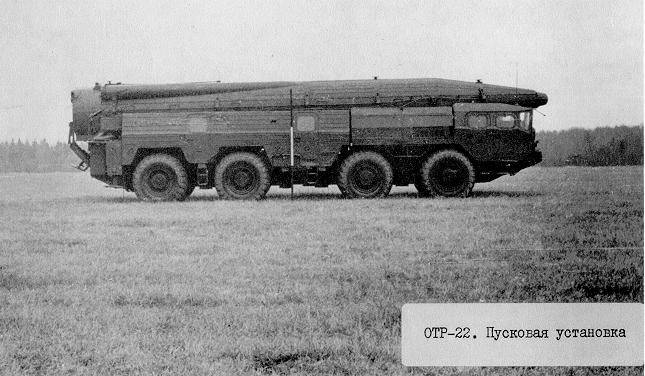
Self-propelled launcher 9P120. Photo of the documents to the agreement on missiles of medium and short range / Russianarms.ru
According to some reports, the appearance of the launcher for the 9K76 complex was not immediately determined. Initially it was planned to use the existing developments, however, these projects were never completed. In the early stages of the creation of the Temp-S complex, it was decided to abandon the placement of launch systems on a semi-trailer or the separation of similar equipment with installation on two wheeled vehicles. An unsuccessful attempt was made to adapt the 9P11 launcher of the Temp complex for the use of the new rocket.
In November, the 1962 of the year, the OKB-221 of the Barricades plant began designing a self-propelled launcher Br-278, which subsequently received the additional designation 9ПХNUMX. This car was based on the special chassis MAZ-120 of the Minsk Automobile Plant. The base machine was completed with a D-543А-12А diesel engine with 525 hp power. and hydromechanical transmission, which distributes torque to eight driving wheels. All this allowed the car to carry loads weighing up to 525 t. It was also possible to tow an 20-ton trailer. The maximum speed of the car reached 25 km / h. Such characteristics were sufficient to use such a chassis as the basis of an operational-tactical missile system.
During the construction of the 9P120 launcher, it was proposed to mount a set of special equipment on the existing chassis. So, on the back of the frame were additional cabins with equipment for controlling the missile complex. In addition, jacks were mounted for stabilization in preparation for launch. The rear of the chassis received a swinging system for storing, transporting and launching a rocket.
Equipment for working with a rocket consisted of several basic devices. Unlike previous missile systems, Temp-S was supposed to transport a rocket in a heated 9YA230 container. This device received a body that completely encloses the rocket placed inside. The rear end of the container was covered with a starting table. The upper (at the transport position of the container) part of the product 9Я230 was made in the form of two drop-down doors.
The launch pad of the Br-278 launcher was a unit with a cylindrical casing, equipped with all the necessary equipment. Provision was made for supporting devices for rockets, drives to turn them in the right direction, gas shut-off shields, etc.
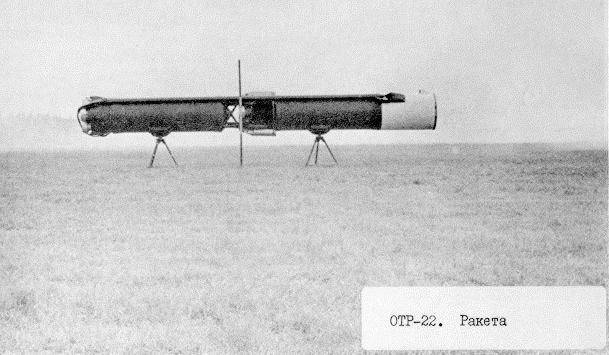
Rocket 9М76 without head. Photo of the documents to the agreement on missiles of medium and short range / Russianarms.ru
In the 9P120 project, an original method of storing and preparing the rocket for launch was implemented. After arriving at the position and leveling the machine, it was necessary to raise the rocket container in a vertical position, after which its flaps opened. The rocket and the launch pad remained in the desired position, and an empty container could return to the roof of the vehicle. The use of the container allowed to significantly improve the storage time of the missiles and the deployment of the complex. So, for deployment from a traveling position, only 25 minutes were required, and when the 9-230 container was in a horizontal position, the launcher could remain on duty for a year. Without a container, a rocket could maintain no more than 2 hours of combat readiness.
The length of the machine Br-278 reached 11,5 m, width - 3,05 m. By preserving the weight of additional equipment and the rocket within the carrying capacity of the chassis, relatively high mobility was provided while maintaining the basic characteristics at the level of the base chassis in other versions.
In addition to the self-propelled launcher for the complex 9K76 "Temp-S" were developed several other machines for various purposes. Missiles with combat units could be transported by 9Т215 transport vehicles carrying a heated 9Т230 container, similar to the 9XX230 product of the 9P120 machine. A characteristic feature of this product was a closed tail end and two wheel axles for transportation over short distances. The 9Т219 transporters used a shorter container that did not have a heating system. It should carry missiles without combat units. To transfer rockets from transport vehicles to launchers, two types of truck cranes were offered. Transporters and cranes were built on the basis of the MAZ-543 chassis, similar to that used as the basis for a self-propelled launcher.
For transportation of warheads, placement of topography equipment, maintenance of equipment, etc. several specialized vehicles were proposed on the basis of the chassis ZIL-131, ZIL-157, GAZ-66, etc. Thus, the rocket battalion should have included a sufficiently large number of various equipment responsible for certain operations during combat duty, preparation for firing or launching.
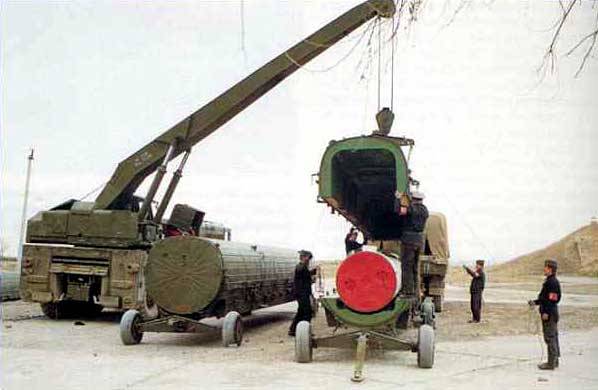
The process of overloading the rocket. Photo Rbase.new-factoria.ru
The Temp-S complex received a controlled two-stage solid-fuel rocket 9М76. In some sources, this product is also referred to as 9M76B and 9M76B1 - depending on the type of warhead used. At the same time, as far as is known, rockets with different combat equipment had minimal differences in design, since they were built on the basis of a single product, the so-called. the rocket block containing the engines and control systems.
Rocket 9М76 divided into several main compartments. The conical head fairing contained a warhead with all necessary equipment. After completion of the active leg of the flight, the head part was to be separated. Behind it was located a relatively small instrument compartment connected to the body of the second stage. The first and second stages had a similar structure with a cylindrical body and a nozzle block on the tail end. Between the steps connected by a light farm and an additional casing for control cables. On the tail end of the first stage there were parts needed to support the starting table. At the second stage, the foldable lattice stabilizers were fastened.
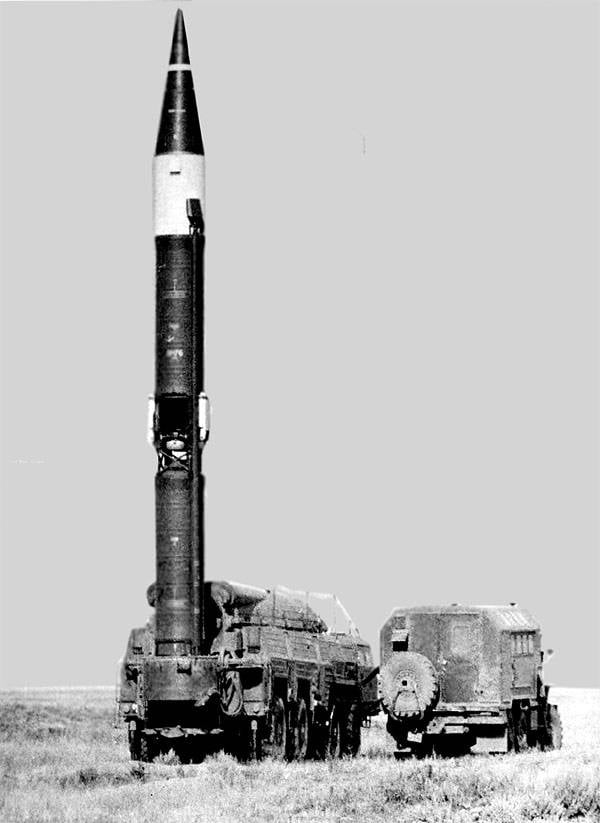
Complex 9K76 in combat position. Photo Militaryrussia.ru
Both stages of the rocket had engines of similar design. The engine housings were proposed to be manufactured from fiberglass by winding technology. Charges of the mixed fuel PEU-7FG were placed inside the case, providing the required thrust characteristics for a specified time. The tail end of the engine was equipped with a bottom with four nozzles. The total mass of the engine charges was 6,88 t. To control the rocket on the active part of the flight, it was proposed to use moving nozzles. The second stage received a cut-off thrust system with the redirection of gases to the nozzles, directed forward in the direction of motion. With their help, the body of the second stage was to be removed from the dropped head part.
According to some reports, by the end of the sixties, the 9М76 rocket engines were upgraded to use new fuel. Now it was proposed to use the charges of mixed butyl-rubber fuel T-9-BK. While maintaining the basic characteristics of this fuel can improve some of the performance of the engine.
An autonomous inertial guidance system based on a gyro-stabilized platform was created for the rocket. The initial guidance in azimuth was proposed to carry out by turning the launch pad in the right direction. After the launch, all operations were carried out by automatic rocket. With the help of lattice stabilizers, an approximate holding of the product on the desired trajectory was provided, and the automatic equipment calculated the deviation from the specified flight parameters and gave commands to the drives of the moving nozzles. After reaching the required point in space, the control system had to drop the warhead and slow down the second stage. After that, the warhead independently and without control drove the ballistic trajectory.
At different stages of the Temp-S project, it was proposed to equip the 9М76 rocket with four types of combat units, but only two similar products reached mass production and operation. The first in the series was the AA-19 combat unit with a thermonuclear charge 300 CT power. Later came the product AA-81 with power 500 CT. At a certain stage, it was planned to complete the rocket with a chemical warhead created for the Temp complex, but this proposal was not implemented.
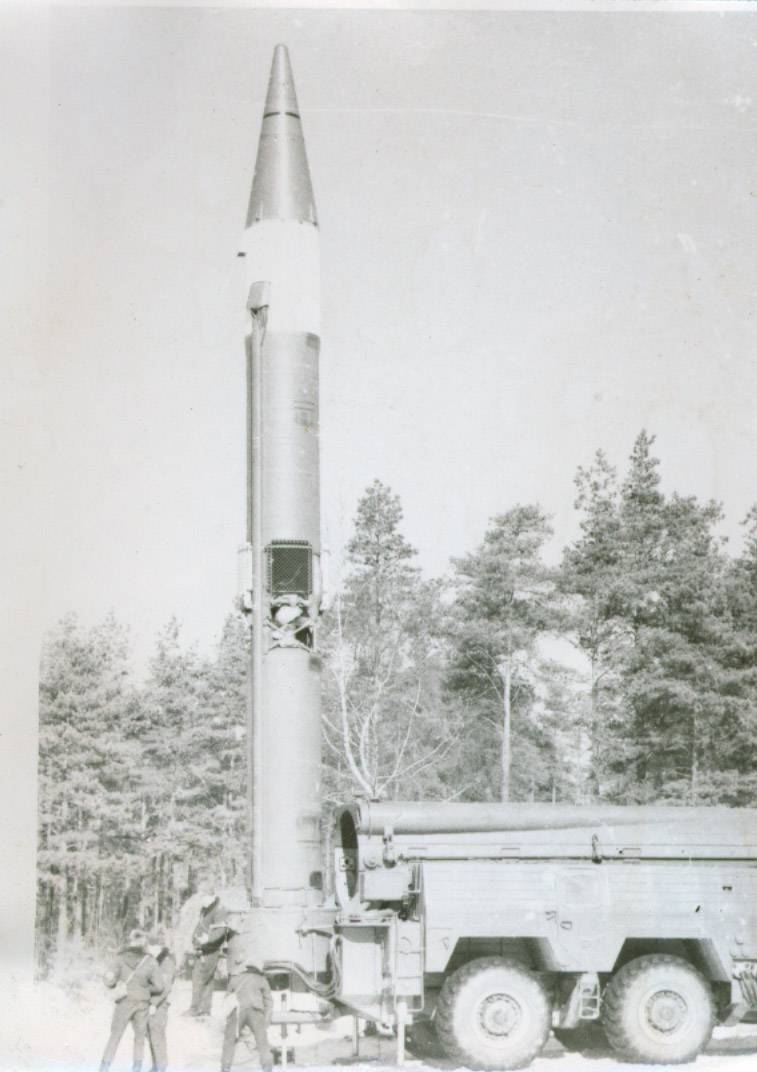
Rocket in the starting position. Photo Russianarms.ru
The 9М76 rocket had a total length of 12,384 m. Of these, 4,38 m accounted for the first stage and 5,37 m for the second. The maximum diameter of the product in the transport position reached 1,2 m. The starting weight did not exceed 9,3 t. The combat unit, depending on the type, weighed to 500-550 kg. In accordance with the technical specifications, the firing range was to be from 300 to 900 km. The circular deviation should be brought to 3 km.
Shortly after the start of the project development, Plant No. XXUMX (Votkinsk) was tasked to prepare for the production of promising missiles. Other enterprises involved in the project received similar instructions relating to other elements of the Temp-S complex 235K9. Due to the need to develop a technical project, it was possible to start the production of the required products only in the second half of 76. By the end of the year, the first prototypes of missiles and other equipment were sent to the Kapustin Yar test site for testing.
The first dummy tests of rockets with simplified equipment took place in December 1963. In March of the following year, the first launch of a full-fledged product was completed, which could deliver the warhead simulator to a distance of 580 km. In the course of the first tests, the 9М76 rocket showed insufficient range and accuracy characteristics, due to which it needed to be improved. In addition, there were several emergency launches with the destruction of missiles in flight. For the processing of the project tests were briefly interrupted.
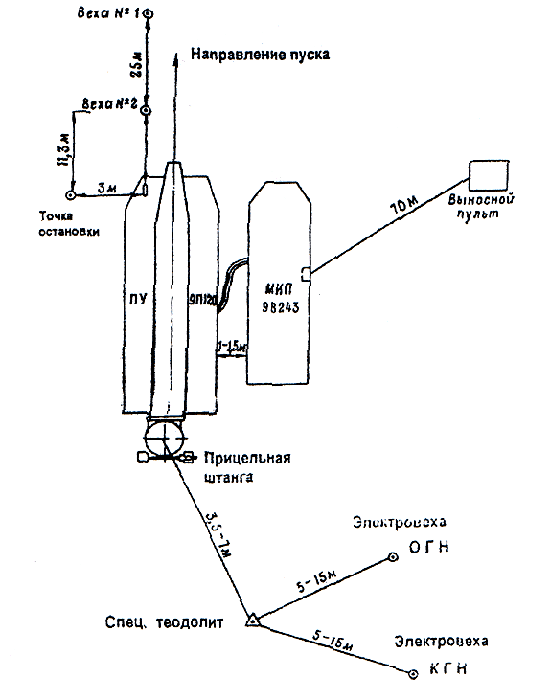
Placement of funds of the Temp-S complex at the position. Figure Rbase.new-factoria.ru
The next stage of inspections was carried out using self-propelled launcher 9P120 and other auxiliary equipment of the missile complex. Prior to the completion of ground tests in 1965, 29 ballistic missile launches, including 8, were performed using a standard launcher. According to the results of all inspections, it was established that the new missile system meets the requirements and is able to solve the combat missions assigned to it. Complex 9K76 "Temp-S" was recommended for adoption.
December 29 The new long-range operational-tactical missile system of 1965 was adopted by the strategic missile forces. Shortly thereafter, preparations began for the mass production of the required products. The release of new products was planned to be entrusted to enterprises that previously supplied equipment for testing. The first serial launchers, missiles and auxiliary machines were handed over to the customer in 1966. In the same year 1966 for the creation of the complex "Temp-S" project leaders A.D. Nadiradze, B.N. Lagutin and A.I. Gogolev were awarded the Lenin Prize.
Simultaneously with the completion of testing of the Temp-S complex, the development of its upgraded version called Temp-SM began. From the base case, this complex should have been different with a new rocket with enhanced characteristics. It was supposed to raise the firing range to 1100 km and reduce the QUO to 1500 m. According to various sources, the updated rocket reached the tests, but was not accepted for service. For certain reasons, it was decided to keep in operation only the existing Temp-S 9-76.
The missile complexes transferred to the troops were distributed between divisions and brigades. The standard battalion had two rocket batteries, each of which consisted of two compartments. The department had at its disposal one self-propelled launcher 9P120 and several auxiliary machines. In addition, the battalion had a control battery, as well as several auxiliary platoons. In addition to the divisions, the missile brigade included several other units responsible for the reconnaissance of targets, the implementation of topographic identification, the issuance of target designation, etc.
According to various sources, in 1967, no more than six rocket regiments armed with Temp-S systems were formed. The vast majority of such units were based beyond the Urals, which was associated with the deterioration of Soviet-Chinese relations. It was proposed to cover the western direction with the help of other missile systems. The operation of the 9K76 complexes by strategic rocket forces did not last long - until February of the 1968 year. After that, an order was issued by the General Staff to transfer existing regiments to the rocket forces and artillery of the ground forces. Now the rocket regiments were to obey the command of the military districts.
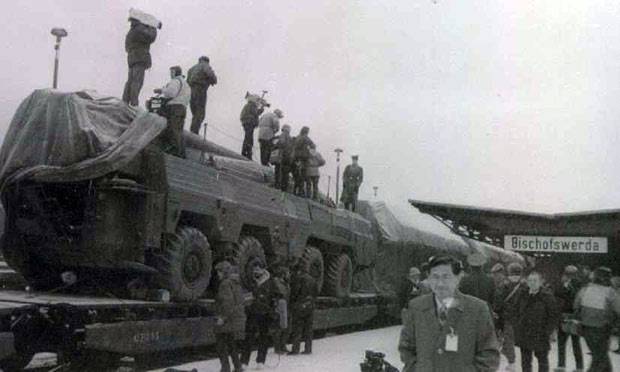
Withdrawal of units armed with Temp-S complexes from the GDR. Photo Militaryrussia.ru
Serial production of machines complex 9K76 "Temp-S" lasted until 1970 year. The latest 9М76 missiles were launched only in the 1987 year. Production volumes were enough to form the required number of units required for deployment in all dangerous areas. At first, Temp-S complexes were deployed only on the territory of the Soviet Union. Later, in the early eighties, the transfer of Temp-S complexes to the Warsaw Pact countries began, where they remained until the end of the decade.
According to reports, by 1987, the armed forces of the Soviet Union had 135 self-propelled launchers 9P120 and the required number of other equipment from the Temp-S complex. For two decades of production, 1200 9М76 missiles with various combat equipment were produced. Equipment and weapons were exploited by several units of the Soviet army on the territory of the USSR and friendly states.
In December 1987, the USSR and the USA signed the Treaty on the Elimination of Medium and Small-Range Missiles, implying the abandonment of complexes with a firing range from 500 to 5500 km. Under the agreement came several domestic missile systems, including Temp-S 9K76. Already in the first days of 1988, the Soviet specialists dismantled the first 9М76 rocket, the operation of which was prohibited by the agreement. This was followed by the cancellation of the existing equipment and the dismantling of the parts that operated it. The last rocket of the Temp-S complex was eliminated at the end of July 1989. After the disposal was completed, only a few self-propelled launchers and a number of missile models were preserved. Currently, all these products are exhibits of domestic museums.
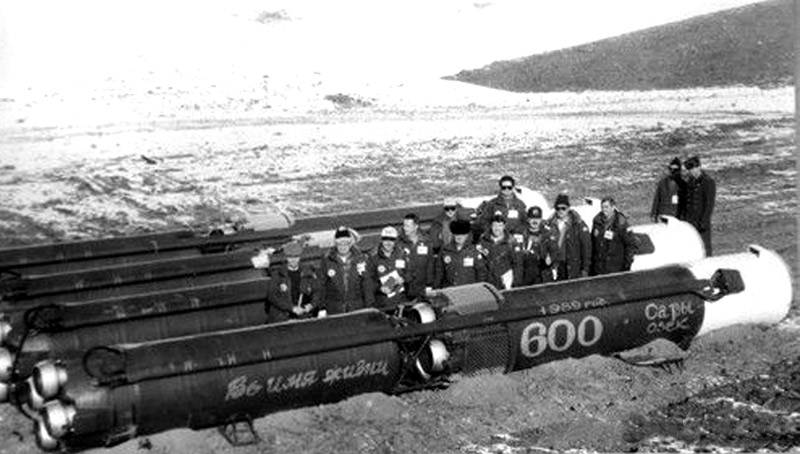
Destruction of decommissioned missiles. Photo Militaryrussia.ru
The tactical missile system 9K76 Temp-S was in service only in the Soviet Union. For export this development was not offered. Some foreign sources mention negotiations on the transfer of such systems or technical documentation to friendly foreign countries. However, such negotiations - even if they were actually conducted - did not lead to the appearance of supply contracts. In addition, while there is no convincing evidence confirming the very fact of such negotiations.
The 9K76 “Temp-S” missile system was created in the first half of the sixties using the existing experience in developing such systems, as well as using the latest technologies, materials and developments. The result of this work was the emergence of the first domestic operational-tactical complex of increased range, using a guided ballistic missile with a special warhead. The project turned out to be quite successful, thanks to which the troops have been using high-performance equipment for two decades. It should be noted that the operation of the 9K76 system ceased, not due to moral and physical obsolescence, but because of the appearance of new international treaties.
Based on:
http://rbase.new-factoria.ru/
http://kap-yar.ru/
http://arms-expo.ru/
http://russianarms.ru/
https://defendingrussia.ru/
http://русская-сила.рф/
http://military.tomsk.ru/blog/topic-193.html
Shirokorad A.B. Atomic ram of the twentieth century. - M., Veche, 2005.
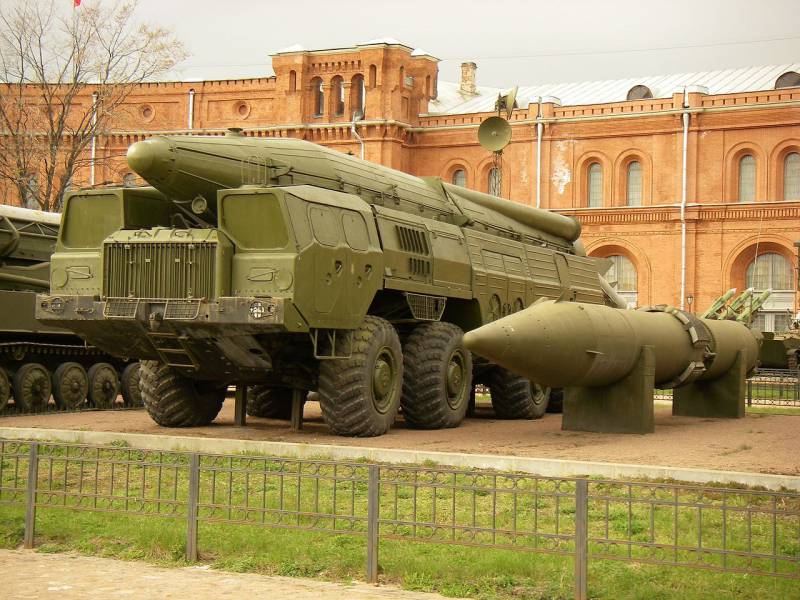
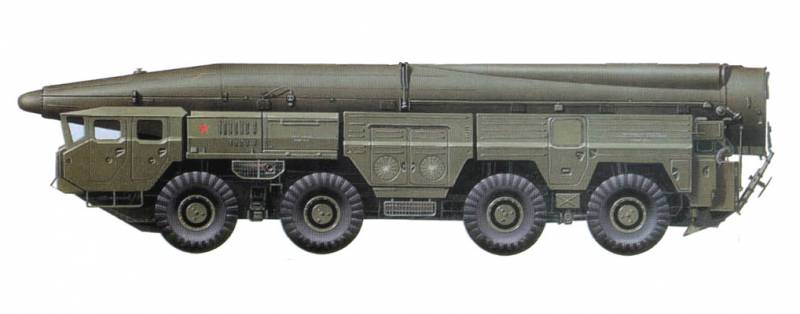
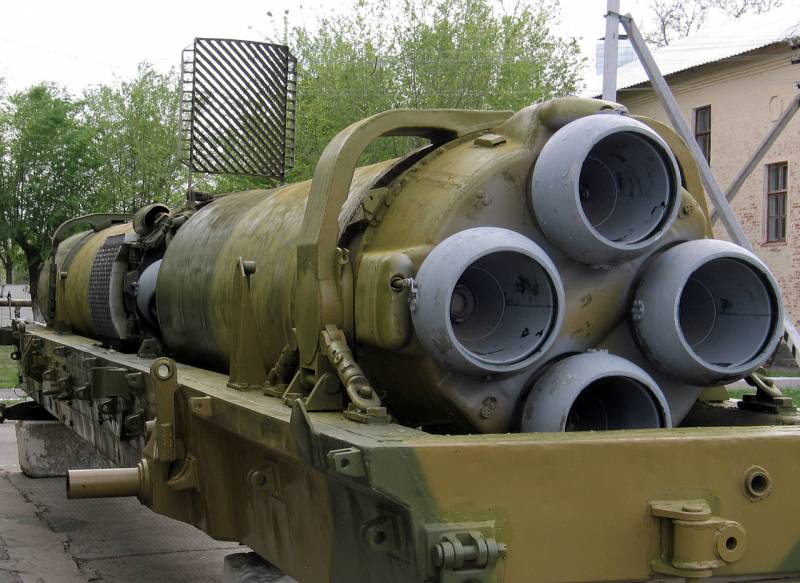
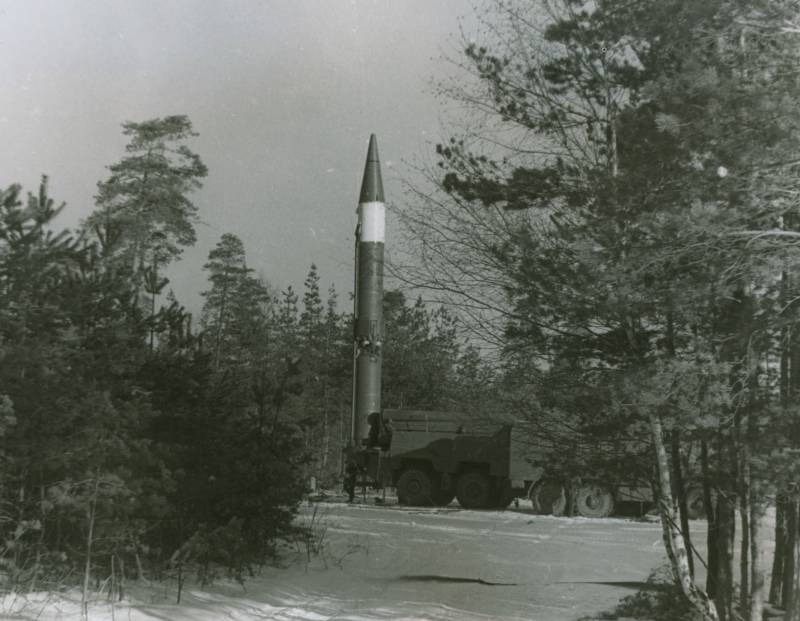
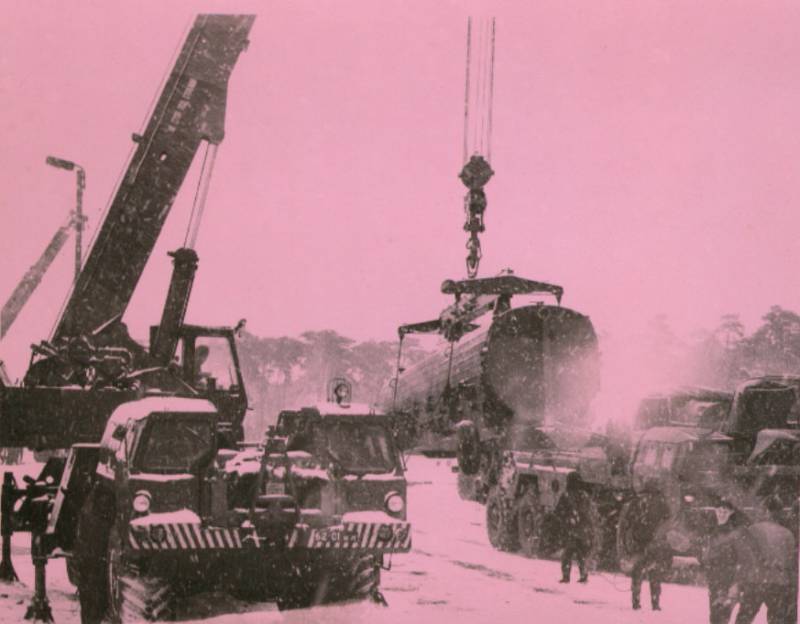
Information